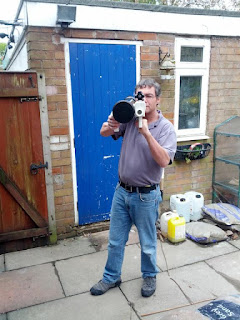Saturday, 19 May 2012
Rocket Launcher Complete
Visit Tagbits to see the full range of tagger products described in this blog.
I've finally completed the RepRap, Milestag rocket launcher build. I stuck a sight on top and took some pics. Going to pass it on to Steve now for painting and the installation of the Milestag electronics.
Monday, 14 May 2012
Milestag rocket launcher...continued
Visit Tagbits to see the full range of tagger products described in this blog.
I've been doing further work on my Milestag rocket launcher. I've been doing further work on the control box.
Here is the CAD drawing of what I want:
I modelled the box on one I found on ebay, then printed out 1:1 scale drawings of the holes for each side. Using spray mount I fixed these to the box. This allows me to centre the holes precisely, especially when I use my optical centre punch:
I used a stepped drill for the cable holes:
I designed a custom LCD display mount with allows me some leeway when I cut a rectangular hole for it in the box. It has a flange to hide rough edges and a recess to allow a 2mm protective cover:
Here is a test assembly of the box:
On the other side you can see the curved mounting plates to allow me fix it to the launcher barrel:
Tuesday, 8 May 2012
uMT Board
Visit Tagbits to see the full range of tagger products described in this blog.
My uMT boards are now available at Tagbits. Jim at Lasertagparts has authorised me to produce my own version of the board which fixes the muzzle flash brightness problem.
Sunday, 6 May 2012
DIY Milestag LDC display cable
Visit Tagbits to see the full range of tagger products described in this blog.
I've been asked to describe how to make a DIY version of the elusive 14way cable used to connect the Milestag Core board to a LCD display.
Make sure that you check that the lead connects the way you want it to before applying power to the circuit.
1) Buy a 14 way IDC connector (e.g.Mouser 71600-014LF)
2) Get some 0.1" spacing IDC cable. You can get this from Mouser etc. but I just recycle old computer disk cables: Make sure that it is not the 'high density' type (shown below) as this kind will not work.
3) Cut the connector off the computer cable with some stout scissors. Try and keep the cut straight:
4) Making sure that you start at the cable that is coloured red (cable 1), count 14 wires and carefully make a small cut in-between wires with a scalpel:
5) Pull off the length of cable required by hand:
6) Feed the cable through the connector and make sure that the red cable is at the same end as pin 1 on the PCB (marked with a square):
7) Hold the connector lightly in a vice. Make sure that you do not tighten the jaws so that they start to close the connector. Feed the cable into the connector and make sure that it pokes out the other side by about 2mm or so. Ensure the cable is straight, and that the conductors are aligned with the 'spades' inside the connector:
8) Close the vice until the connector latches snap into place:
9) Cable is complete, repeat for the other end if required:
Saturday, 5 May 2012
Safer.....Probably
Visit Tagbits to see the full range of tagger products described in this blog.
I managed to repair my heated bed after nophead kindly brought a replacement power resistor into work last Monday.
When I've been printing large (200mm x 60mm) ABS parts I have relied upon the heated bed of my printer to keep the chamber hot enough to prevent warping. I later added a temperature controlled hot air gun to heat the chamber as in winter, the bed alone fails to keep it hot enough.
The hot air gun was software controlled through the PC parallel port, via an interface board. At the end of every vector, the software queries the cabinet temperature and turns the heater on if required.
This scares me. If the controlling software, or Windows, crashes. I am left with a heat gun dumping its output into my heated chamber with no control. I don't want to come back to find my printer melted, or my garage on fire.
So today I built this:
It is a combination of a thermostat and power relay. My PC controls the relay, and turns on power to the mains socket when the cabinet needs heating. The power is routed through the thermostat, so that if the relay is left on for too long, the maximum cabinet temperature is limited by the thermostat.
The worst case scenario with this configuration is that I return to find a failed print and a hot cabinet. But at least I will still possess a printer and a garage.
The sensor part of the thermostat looks a bit ugly inside the cabinet though:
Subscribe to:
Comments (Atom)





















